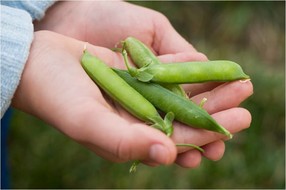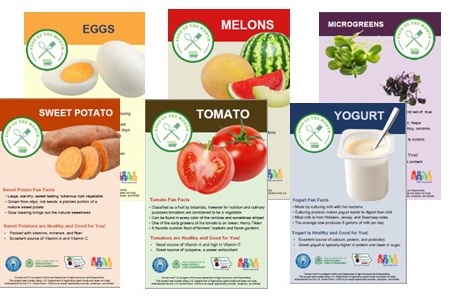
New legislation in Iowa is leading to continued growth in farm to school. The need to alleviate disruptions in the food supply chain during the COVID-19 pandemic led to the passage of the Iowa Department of Agriculture Senate File 578 and the creation of a Farm to School Fund this June. Originally inspired by the Local Produce Fund in Maine, this opportunity offers a win-win for farmers and students within Iowa to expand farm to school efforts and help increase locally-produced foods in school meals and snacks.
Coronavirus Aid, Relief, and Economic Security (CARES) Act funding started in the fall of 2020, giving Iowa the opportunity to gauge need and build support for schools and farmers. Over $600,000 was spent on this program in a few short months and the results got the attention of lawmakers across the State.
“The COVID-19 pandemic has reinforced the critical role Iowa farmers play in the local food chain and beyond, as well as the important role of schools in providing nutritious meals to our students,” said Iowa Secretary of Agriculture Mike Naig.
As part of CARES Act funding, the Local Produce and Protein Program consisted of three mini-grant programs including $5,000 equipment grants to farmers and schools for equipment needed to process or offer local produce. In addition, up to $2,000 was available per school building for the purchase of Iowa grown or raised farm products with at least half of the purchase being produce. The State has seen tremendous growth since the Farm to School Program was legislated in 2007, and the events of 2020 demonstrated the need for a vibrant local food system. The new legislation for the Farm to School Fund offers schools the opportunity to receive up to $1,000 for $3,000 spent on local produce or protein.
“While not a massive amount of money, we believe this program will help incentivize schools and farmers to engage with each other, which is the ultimate goal,” said Tammy Stotts, Farm to School Program administrator.
The program can be funded by both public and private sources through grants or other contributions. Grant opportunities have consistently played a role in promoting Iowa agriculture within their schools. The Iowa Department of Agriculture and Land Stewardship Choose Iowa™ campaign was developed to support farmers, drive demand for the products they produce and generate excitement about agriculture innovation happening in Iowa.
|

The Iowa Department of Education received a USDA Farm to School State Agency Grant in 2020 to expand the campaign to schools, childcare and summer food programs through the development of Choose Iowa™ Food of the Month learning activities and promotional materials that feature locally grown and produced foods.
Iowa’s success in farm to school is due in large part to the successful collaboration of a dedicated group of farm to school and early care stakeholders who work toward shared goals. The Iowa Farm to School and Early Care Coalition meets regularly and includes strategy teams and shared work including the support of Iowa Local Food Day every October. The new legislation will continue to increase access to locally grown food for children and families in Iowa by building cross-sector partnerships in schools and the food system.
|
In Case You Missed It! USDA Awards $12 Million in Record-Breaking Farm to School Grants, Releases New Data Showing Expansion of Farm to School Efforts
On July 15, USDA announced $12 million in Farm to School Grants for school year 2021-2022, awarding 176 grantees, the most projects funded since the program began in 2013. The department also released new data from the 2019 Farm to School Census demonstrating the recent growth of farm to school efforts nationwide. Nearly two-thirds (65%) of school districts and/or local entities responsible for school meals participated in farm to school activities during school year 2018-2019, more than half (57%) of which began within the past three years. You can explore the results on the new interactive Farm to School Census website: https://farmtoschoolcensus.fns.usda.gov/
Check out the Special Edition of the Dirt, along with the 2021 Press Release and List of Awardees.

Submit Farm to School Resources to the Institute of Child Nutrition Child Nutrition Sharing Site!
The Child Nutrition Sharing Site (CNSS) has added a Farm to School topic area to the Resource Hub! In collaboration with the Institute of Child Nutrition (ICN), the USDA FNS Office of Community Food Systems (OCFS) is building the Farm to School Database and welcomes YOUR farm to school resource submissions! As farm to school continues to grow across the country, it is important for stakeholders to have the opportunity to share and access farm to school resources. The ICN CNSS Resource Hub is a one-stop-shop for Farm to School grantees, State agencies, and other partner organizations to host and promote these resources.
To submit resources to the Farm to School topic category in the CNSS Resource Hub, visit the Submission Form and under “Type of Program”, choose Farm to School and complete the form. OCFS will be choosing new resources to feature in upcoming issues of the Dirt, so submit today!
|

Offering Smoothies as Part of Reimbursable School Meals
Is your school serving smoothies this year? Team Nutrition’s Offering Smoothies as Part of Reimbursable School Meals provides sample menus, crediting tips, and more to help schools offer smoothies as part of a reimbursable school breakfast or lunch. This guide also showcases success stories that show fun and creative ways that schools around the country have offered smoothies to their students, including using fresh produce from school gardens.
|

Back to School: Watch Out for Water Safety!
As preparation for the upcoming school year continues, it’s important to include water safety in your back-to-school plans. When a building is closed for an extended period, or when less water is used because fewer people are there, the safety of the water may be affected. Hazards that may result from stagnant water in a plumbing system include mold, bacteria that cause Legionnaires’ disease, and contamination with metals from corroded plumbing, such as lead and copper.
Actions may need to be taken to ensure the water is safe for drinking, handwashing, and meal preparation. Protecting public health by providing safe drinking water is a team effort. Partner with others in your school community to:
- Flush the water lines to remove water that has been standing in the pipes and replace it with fresh water.
-
Test the water if there is any concern that levels of lead, or other contaminants, may have increased.
- Document all actions taken to monitor and maintain water quality. Records will help to identify and verify necessary steps.
- Develop a water safety plan, which can be used for long-term decision making, routine maintenance activities, and emergency situations to ensure that safe water is always available.
-
Check the water quality by periodically reviewing your Consumer Confidence Report (CCR), which is an annual drinking water quality report that local water suppliers provide.
- Continue maintenance activities during closures, such as routine cleaning of drinking water areas and sources like water fountains and faucets.
For more information, visit the USDA Food and Nutrition Service Back-to-School Water Safety Resources webpage.
|
NIFA Invests $6.2M to Prepare More Teachers in Food and Ag Science
The USDA National Institute of Food and Agriculture (NIFA) announced on July 7 an investment of $6.2 million for 21 Professional Development and Secondary School Teacher grants that will increase the number of K-12 teachers and educational professionals trained in the food and agricultural sciences. These grants are part of NIFA’s Agriculture and Food Research Initiative.
“As we work to build the talent pipeline for agricultural science, technology and business, we have to reach young people while they are in high school,” said NIFA director Dr. Carrie Castille. “With this support from NIFA, teachers can develop skills necessary for integrating food and agricultural science into their classes; explore food and agricultural science career paths; and forge mentorships with agricultural professionals, business leaders and university faculty that will help guide the next generation of agricultural scientists and leaders.”
Funded projects in this program support best practices in teaching that enhance student learning outcomes. Visit www.nifa.usda.gov to learn more.

Marketing Agroforestry Products: Lessons from Producers
The USDA National Agroforestry Center recently published Marketing Agroforestry Products: Lessons from Producers. Many farmers, ranchers, and forest owners are exploring agroforestry, the intentional integration of trees and shrubs with crop and animal production systems. This publication highlights producer and intermediaries' experiences with marketing agroforestry products, including how operations entered into or created the markets for their products.
In-depth case studies showcase how these entities, including Hawai’i Ulu Cooperative, a FY18 Farm to School grantee, utilized USDA and other federal, State, and local programs, capital, and technical assistance at different phases of market development. This is a great resource for projects looking to introduce new products to market or expand marketing opportunities. Check out the document in its entirety or individual case studies covering a variety of products, including pecans, ramps, maple syrup, elderberries, pawpaws, herbs, and ulu fruit.
|
|